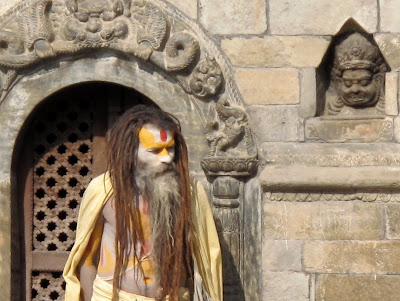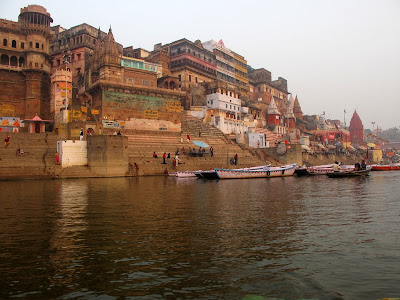The Holy Ganga of Varanasi
Varanasi, the holiest of holy cities, has as many visually-charged epithets as one would expect. It is the city of death and pilgrims; the city of learning and burning. All life (and inevitably death) revolves around the Ganges River, also known, simply, as Ganga. There is more folklore flora and religious fauna to fill up five blogs, so please excuse me if I heavily abbreviate.
 We meandered down the river in the early morning hours; the sky softened into a wispy dawn. Birds scattered and swarmed in play.
We meandered down the river in the early morning hours; the sky softened into a wispy dawn. Birds scattered and swarmed in play.
...and endearing goats wearing shirts to stay warm...
...and sadhus, ascetics whitewashed in ash, otherworldly yet not at all out of place on the steep ghat steps.

At the large ghat, the burning goes on 24 hours a day producing up to 200 cremations. An average pyre costs 3000 rupees ($60) but can vary in price depending on the quantity and qualify of wood used and the priests services rendered. The eldest son takes a place of prominence in the funeral ritual, releasing the final bits of bone and ash into the river where they sometimes scavenge the remains and pick out pieces of jewelry and gold fillings.

It might be a shocking enough use of the foul brown river water - with all the dead bodies, ashes, and human waste flowing in it - but even more disturbing is when the locals scoop up in their hands and drink it!! Although they purport these to be holy waters with true medicinal value, it is filthy beyond imagination. Do they know that the amount of ecoli bacteria and fecal coliform are 3,000 times worse than the safe level determined by the World Health Organization? Yuck.
We hired Aso another night for a boat trip to see the Ganga puja or Brahmin ceremony. Every evening at 6pm at the Prayag ghat, five Brahmin offer aarti or prayer, through circling lamps and incense, singing, drumming and chanting.
We were accompanied by Aso’s three daughters who were eager to sell us their handmade wares and fledgling services. The oldest was so persistent, I relented and had my first henna, a loopy twisting design on the back of my hand, painted on by the faintest candlelight. Admittedly, a rocking, dark boat may not have been the wisest choice for semi-permanent body art; it was sloppy and amateurish, but the girl was proud and so was I.
 Hundreds of diyas floated on the river like twinkling stars in the inky sky. A prayer in each one, and in each heart.
Hundreds of diyas floated on the river like twinkling stars in the inky sky. A prayer in each one, and in each heart.










0 comments:
Post a Comment